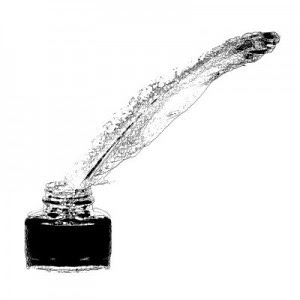
The ink is colored materials that contain color pigments used to color a surface. Ink with pen and pencil are used to write and draw. The ink is a very complex medium, containing solvent, pigment, dye, resins and lubricants, sollubilizer (sort of compounds that form ions with the polar polymer resin waterproof), surfactant (ie wet element that lowers the surface pressure of a liquid, allowing Easy deployment, surfactants also reduce the pressure between the surface between two liquids), particulate materials, pemijar, and other materials. The components of the ink running multiple functions: carrier inks, dyes, and materials and other addiktiv used to regulate the flow, thickness and shapes of ink when kering.bahan
History
Many ancient cultures of the world have independently discovered and formulated inks for the purpose of writing and drawing. Knowledge of ink, their recipes and techniques for their production comes from the analysis of archaeological or written text itself.
History of Chinese ink can be traced back to the 12th century BC, with the utilization of natural plant (dyeing plant), animal and mineral based materials such as ink graphite is ground with water and applied with brush ink. Evidence for the earliest Chinese ink, similar to modern inksticks, is around 256 BC in the late Autumn and manufactured using manual labor from the soot and animal glue.
India ink used in ancient India since at least the 4th century BC were called masi is made of burnt bones, tar, pitch, and other materials. Kharosthi document written in India ink have been unearthed in Chinese Turkestan. practice of writing with ink and needle sharp points common in southern India early Several Jain sutras in India were compiled in ink.
In ancient Rome, atramentum used. In an article in the Christian Science Monitor, Sharon J. Huntington describes these other historical inks:
About 1,600 years ago, popular ink recipe was created. Recipe was used for centuries. iron salts, such as iron sulfate (made by treating iron with sulfuric acid), which was mixed with tannin from gallnuts (they grow on trees) and a thickener. When first for paper, ink is bluish black. Over time it fades to dull brown.
Clerk in medieval Europe (about AD 800-1500) writes mainly on parchment or vellum. One 12th century ink recipe called for hawthorn branches to be cut in the spring and left to dry. Then the leather was pounded from the branches and soaked in water for eight days. Water boiled until thickened and turned black. Wine added during boiling. ink was poured into special bags and hung in the sun. After drying, the mixture was mixed with wine and iron salt over a fire to make the final ink.
Reservoir fountain pen dates back to 953, when Ma'ad al-Mu'izz, caliph of Egypt, demanded a pen which will not stain hands or clothing, and is provided with a pen which held ink in a reservoir and delivered to the nib via gravity and capillary action.
In the 15th century, a new type of ink must be developed in Europe for the printing press by Johannes Gutenberg. Two types of ink were prevalent at the time: Greek and Roman writing ink (soot, glue, and water) and various 12th-century consisting of iron sulfate, bile, candy, and water. Both of ink handwriting can be attached to the printed surface without creating blurs. Eventually an oily, varnish like ink made of soot, turpentine, and walnut oil was created specifically for printing.
No comments:
Post a Comment